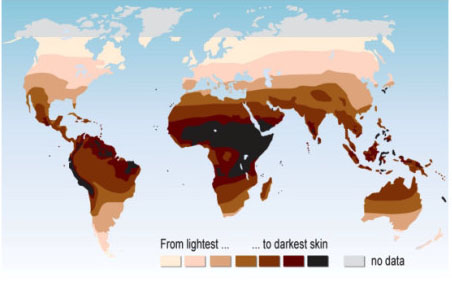History’s Bias Appropriation of Skin Tone
Skin tone gradient, and by extension, race, ranks atop the subjects we are most ignorant of because it is not taught in school, and it is often the basis of the pecking order in a modern world conquered and ruled by European standards. Additionally, the Manichean belief in lightness versus darkness (good vs. evil) that underpinned social and religious consciousness pre-antiquity (Osiris and Isis, for example) has evolved through time and still plays an ignorant role in western religions and modern culture.
Based solely on skin tone, India’s caste system has endured for many millennia. From the Brahmins at the top of the heap to the so-called “Untouchables at the bottom, it is an example of such ignorance and the punitive role of skin tone’s prevalence through time.
Another is the infamous “Hamitic Theory” that the Old Testamentalists used to justify slavery – that Africans got their “burnt” skins by a curse of God. Supposedly, they are the offspring of Noah’s youngest son Ham, who God had condemned for having laughed at his father after seeing Noah in a drunken stupor. If true, what a brutal God we would be serving?

Then, there was history’s recording of Hernando Cortés’ supposed claims that on arriving in Mexico in 1519, because of his white skin, the Mexicans “welcomed” him as a god – believing he had returned to satisfy an ancient prophecy. Cortés never wrote such claims, but others did, and later writers magnified the claim. Fray Toribio de Benavente, for example, wrote that in seeing the armada, the indigenous Mexicans believed that, “Their god was coming, and because of the white sails, they said he was bringing by the sea his own temples.” The cause would later morph into “because of their white faces – their skin tones.”
In Polynesia, there was the “Cargo Cult” of Melanesia in the aftermath of World War II. Natives worshipped the “magic” of the visiting American warships, whose crew, hardware, and cargo they perceived to be of divine origins. Several cargo cults then sprung up on other islands, including on Vanuatu, where they worshipped the “King of America,” John Frum – a mythical bleach-faced white man whom they perceived as the god responsible for their rich endowment of goods, the god who would liberate them (while colonizing them).
And then one of the funniest skin tone anecdotes ever told came from Lady Flora Lugard’a African epic, “A Tropical Paradise.” The great Mansa Musa was the 14th-century king of the Songhay empire and then the world’s richest man. When a white judge in the employ of the Sultan of Melle had embezzled money intended for public use, the Mansa put him on trial and banished him to the country of the pagans “who eat men.” But the judge survived the ordeal because “the cannibals did not eat him because he was white. They say that the flesh of white men is unwholesome because it is unripe. Black flesh alone, in their opinion, is ripe.”

With all the horrors that befell the African hinterland of the 14th-century (Moorish slave raids and depredation, warring nation-states, cannibalism, and so forth), circumstances seemed to have smiled upon a white man, whose skin tone saved him, not by any belief in his superiority or godliness, but by a superstition that deemed him inferior meat kind at the dinner table.
Contemporary Skin Tone Paradox
The modern paradox of skin tone gradients – black or dark versus white or lighter tone – is that human beings of each hue are generally desirous of the other. Paled skin white people flock to the tropics for vacation or to the beach during summertime to toast themselves in the sun. So desirable is the “tan” in modern times that it now ranks in the definitional lexicon of beauty and commands a multibillion-dollar industry of cosmetics and safety products.
On the other hand, darker-skinned people, particularly Africans (African descent), Asians (Asian descent), and others of dark skin tones, are desirable of lighter skin tone. White or lighter skin tone is perceived as of higher social ranking, associated with the wealthier and more educated classes in many parts of the world, and in many cases, the basis of beauty among the darker-skinned people of the world.
In Africa, Asia, the Caribbean, North and South America, “bleaching” (chemically removing pigmented skin or reducing pigment production) has become a Codice verbum for self-hate and the dominance of color creed supremacy. Given a choice, many would chose a lighter skin tone, date and marry a light-skinned spouse, and produce lighter-skinned offspring. Simply put, light is right.
Natural Selection and the Science of Skin Tone
Despite a long history of religious propaganda, cultural supremacist ideologies, and racist pseudo-science, skin tone is purely a function of science – efficient biological variation under what Charles Darwin had identified as “Natural Selection.” It is an example of species adaptation for survival. Darker toned skin better equips the body for survival in sunnier places, while lighter skin better equips it for survival in less sunny regions. This variation-adaptation comes through endowed pigmentation in the former and depigmentation in the latter. It is the departure point to the black and white races.
There are two important points in understanding skin tone variations. The first is melanin production or pigmentation. Melanocytes cells, found in the skin’s outer layer, produce melanin – the pigment that gives color to skin, hair, and eyes. The second point is that skin tone varied as a global gradient, with populations growing darkest as we near the equator and lightest near the poles. Evolution was a smart and efficient process, and this is the result of a smart and efficient process evolutionary purpose, dictated by nature and location.
Scientists believe that variation in human skin tone is a function of evolutionary balancing act tens of thousands of years in the making. Human skin tone variation started in Africa, producing pigmentation dark enough to prevent sunlight from destroying the nutrient Folate and light enough to foster vitamin D production.
As we have learned, “the woman is the cradle of civilization.” This is largely due to her reproductive capacity. Evolution (Us) would be nowhere without her. So the evolutionary selection/variation of pigmentation satisfied conflicting demands of two essential vitamins: the body’s need to protect Folate and its need to produce vitamin D.
Folate is a B-vitamin needed to make red and white blood cells in the bone marrow. It converts carbohydrates into energy and produces DNA and RNA. Still, its major impact is on evolutionary fitness — the human’s ability, not just to survive, but also to reproduce — through fetal development. Adequate Folate is crucial during rapid growth periods such as pregnancy, infancy, and adolescence. If pregnant women don’t have enough Folate, it can lead to neural tube disorders like spina bifida – a condition where the vertebrae do not fuse completely around the spinal cord. Most neural tube disorders are debilitating or fatal.
Experiments have shown that sunlight breaks down folate – as an isolated molecule, in blood plasma, and in skin biopsies. Darker skin tone impedes this breakdown because it contains higher amounts of melanin – the dark-brown pigment that absorbs UV rays and chemically disarms their harmful by-products.
Vitamin D is not a vitamin but a prohormone or precursor of a hormone. The body produces it naturally on exposure to the sun. It is essential for strong bones, muscular development, and maintaining healthy bones and teeth because it helps the body synthesize the calcium we get from our diet. Vitamin D is also essential for protecting us against diseases and other maladies, such as type 1 diabetes. We must remember that evolution’s first concern was our fitness to survive – the nut and bolts of which was muscular development and illness prevention in early humans.
The sun’s ultraviolet (UV) radiation produces vitamin D, and as mentioned, it also destroys Folate. Therefore, humans needed the right amount of sun exposure that to accomplish both. Because the intensity of UV rays is dictated by geography, the body’s adaption through levels of pigmentation determines the amount of UV rays that actually penetrates the skin. The sunblock needs at the beach for white or pale-skinned (lower levels of pigmentation) in the northern hemisphere is to protect the skin against sunburn and skin cancer, the body’s reaction to (the symptom of) exposure to intense sun and excessive UV exposure, for which it was “deselected.”
I am of a darker skin tone, and at a certain stage, while living in New York, my annual physical exams continually revealed a Vitamin D deficiency. In checking with friends and family of similar skin tone who live in Florida, they had no such problem. On the other hand, the reverse might be true for a white or pale-skinned New Yorker of similar age and lifestyle. S(h)e will likely not suffer my Vitamin D deficiency levels in New York, but as a transplant to Florida, will be exposed to sunburn and higher risks of skin cancer – risks that I do not engender under the same conditions.
Shedding Our Furry Skin
As with most things with potential racial content, skin tone discussions are more emotional propaganda than science. I have heard debates in the past that asserted that “the first man on earth was black” or that “he” was white. Without addressing the obvious gender bias, science tells us that s(h)e was neither.
Early hominins – our ancestors (progenitors) several million years ago – were big or little bulky furry creatures. They were hairy with pale skins underneath, much like our closest evolutionary cousins, chimpanzees and gorillas (with whom we all share a unique progenitor) are decked in fur that covers a pale skin underneath.
As we shed this fur, we variated through pigmentation selection to protect our skin. As we lost our furry selves, the skin tone tradeoff is thought to have occurred when our bare skin became exposed to intense, year-round UV rays. Evolution selected higher melanin levels to produce pigmentation and a darker skin tone as this better protected our Folate stock.
While estimates of the timing and causes (triggers) vary, many scientists believe that it was roughly 1 to 2 million years ago – the time our ancestors moved to start walking upright. As humans transitioned from quadrupeds (on all fours) to bipeds, we also shed our furry overcoat to stay cool as we roamed equatorial Africa as walking bipeds, upright on two feet. Animal cruelty aside for a moment (though difficult), the pervy naked “flashers” who roamed the streets of New York exposing themselves in the 1970s and 80s might have just been aspiring to connect with the past – in a city most alienated from nature
Outside the Tropics – My Vitamin D deficiency Issue Explained.

Pinpointing the timing of human lineage migrations out of equatorial Africa might paint better estimates of the timing of variation-adaptation. I have read various estimations of the timing, starting from 80,000 to 120,000 years ago and continuing for tens of thousands of years since. Although this is not necessarily the timing of the change in European pigmentation, at some point, humans in the northern hemispheres would pose evolution a nasty little problem to solve: Vitamin D deficiency.
As already mentioned, Vitamin D is equally important for evolutionary fitness, as it facilitates the absorption of calcium, necessary for healthy bones and immunity. The body produces it naturally but only when activated by UV ray wavelengths. But outside of the tropics, there is not enough UV of the right wavelength for skin cells to produce enough Vitamin D for most of the year.
A 1980 study showed this using fresh foreskin collected from white babies circumcised in Boston. The researchers divided each sample in half. Then, they exposed one part of the foreskin sample to three hours of midday sun while keeping the other sample in the dark. In the spring through fall months, the sun-exposed skin produced the precursor for vitamin D, as would happen in a living human. However, no measurable precursor was produced during winter, up until March 17.
So, to get sufficient Vitamin D year-round in northern hemisphere locations like Boston, people have to rely on body-stock built up during the summer months or acquire the nutrient through foods, like fatty fish. But the darker the skin tone, the harder it is to produce and maintain adequate vitamin D levels under less intense sunlight.
So what was evolution’s response? It reduced the pigmentation (white skins) of those who had migrated out of the tropics to higher latitudes to allow in more UV rays. The reduced pigmentation allowed their bodies to absorb more of the lower-intensity UV rays, thereby producing adequate Vitamin D levels. In studies comparing dark and light skin-toned residents of northern cities, paler people had higher vitamin D levels throughout the year.
Sporadic Adaptation

With sophisticated genome research of recent years, scientists have come closer to identifying the character and timing of the white skin tone of modern Europeans. Modern humans who came out of Africa to settle Europe up to about 40,000 years are presumed to have had dark skin tone – as they were adapted to sunny latitudes.
Researchers found that evolution’s mix bag had produced three separate genes that produce light skin in different places, telling a complex story of how Europeans evolved to a much lighter skin tone during the past 8000 years. For example, new data confirm that about 8500 years ago, early hunter-gatherers in Spain, Luxembourg, and Hungary had darker skins. Initially, they lacked versions of two genes – SLC24A5 and SLC45A2 – that lead to depigmentation and pale skin in Europeans today.
But in the far north, where low light levels favor pale skin, scientists found a different picture in hunter-gatherers: Seven people from the 7700-year-old Motala archaeological site in southern Sweden had both light skin gene variants – SLC24A5 and SLC45A2. They also had a third gene, HERC2/OCA2, which causes blue eyes and may also contribute to light skin and blond hair. Thus ancient hunter-gatherers of the far north were already pale skin toned and blue-eyed, while those of central and southern Europe had darker skin tone.
Then the first farmers arrived in Europe from the Near East, carrying both genes for light skin tone. As they interbred with the indigenous hunter-gatherers, one of their light-skin genes swept through Europe, so central and southern Europeans soon began to have lighter skin tones. The other gene variant – SLC45A2 – was at low levels until about 5800 years ago, when it swept up to high frequency.
Finally, as paleoanthropologist Nina Jablonski of Pennsylvania State University (Penn State) summed up adaptation through pigmentation variation, the likely explanation for the pigmentation genes is to maximize vitamin D synthesis.
Conclusion
While skin tone variation is a small part of evolution’s long road of survival, there are many other aspects of our contemporary character and capacities that we take for granted, which our ancestors – black, white, and other – did not possess.
For example, scientists have discovered that hunter-gatherers in Europe could not digest the sugars in milk 8000 years ago. Farmers who came from the Near East about 7800 years ago and the Yamnaya pastoralists who came from the steppes 4800 years ago lacked the LCT gene version that allows adults to digest sugars in milk. It wasn’t until about 4300 years ago that Europe became lactose tolerant.
Complex traits, such as height, are the result of the interaction of many gene types. The massive migration of Yamnaya herders from the steppes north of the Black Sea is believed to have brought Indo-European languages to Europe about 4500 years ago. These Yamnayas had the greatest genetic potential for being tall of any of the populations, as evidenced by the measurements of their ancient skeletons.
Scientists found that natural selection strongly favored several gene variants for tallness in northern and central Europeans, starting 8000 years ago. This trait got a boost from this Yamnaya migration, starting 4800 years ago. In contrast, natural selection favored shorter people in Italy and Spain starting 8000 years ago. Spaniards, in particular, shrank in stature 6000 years ago, perhaps as a result of adapting to colder temperatures and a poor diet.
In conclusion, from changes in DNA structure to the overall modification of our genetic and cell structure, natural selection’s adaptation took many forms of variations on the long continuum of time, at each stage, favoring the appropriate changes required to survive.
External Sources:
On the Origins of Species by Charles Darwin
Journal of Human Evolution, Vol 30, Issue 1: “The Evolution of Human Skin Coloration,” by Anthropologist Nina Jablonski, and geographer George Chaplin.
Discover, “Humanity’s color gradient probably has little to do with sunburn,” by Bridget Alex January 28, 2019
